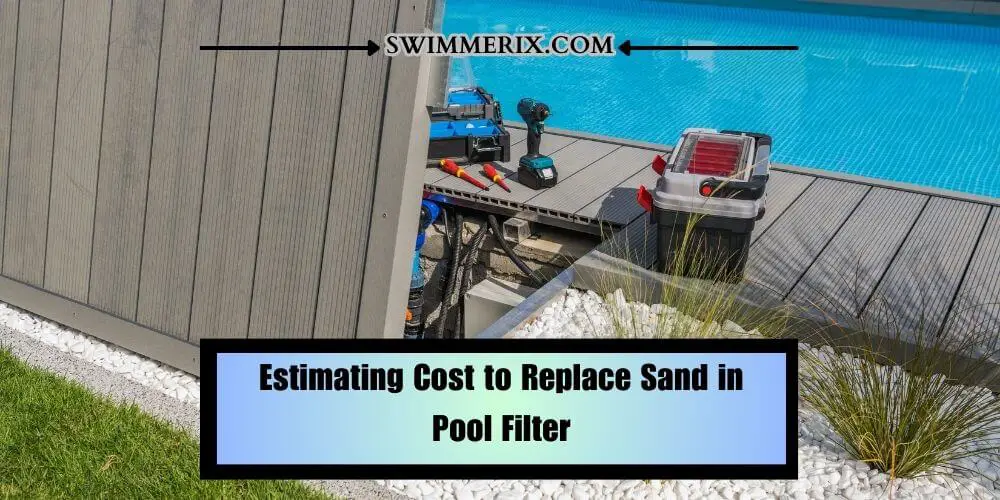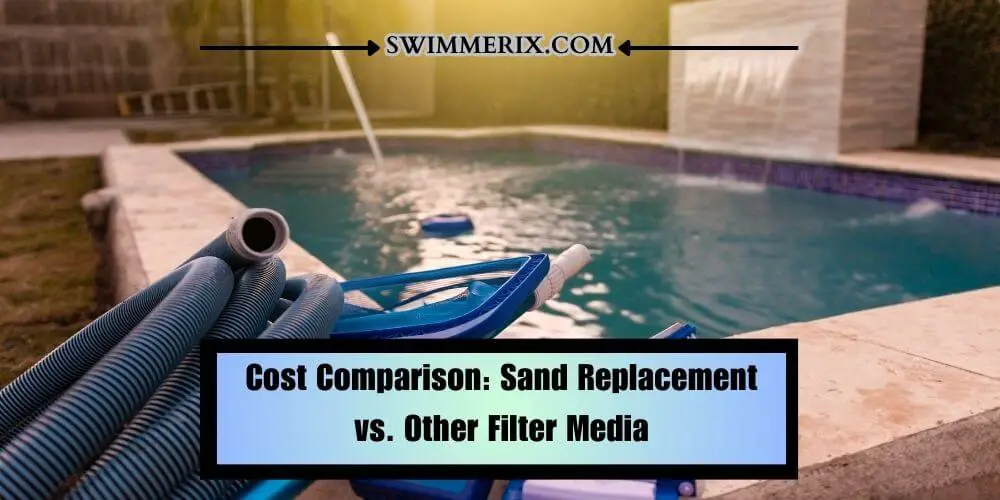
You all know how important it is to have a clean & well-maintained pool for the optimal functioning of your pool as well as a safe & rewarding swimming experience. Over time, this sand in your pool filter can accumulate debris & impurities, reducing its effectiveness. If so, you must replace the sand to ensure efficient filtration and maintain optimal water quality in your water pool. Therefore, if you want to know the ‘cost to replace sand in pool filter,’ this article is for you.
In this comprehensive guide, we will not only learn ‘how much it costs to replace sand in a pool filter’ but also the factors that may influence the cost & various aspects of replacing the sand in your pool filter. But before I tell you what factors might affect the cost of sand replacement in a pool filter, let’s know the average cost to replace sand in a pool filter.
Estimating Cost to Replace Sand in Pool Filter

Depending upon the quantity of sand required, the price of the chosen type of sand, the type & size of the filter, and the lower labor charges in your area, the cost to replace sand in a pool filter may vary. Generally, sand for a pool filter ranges from $20 to $40 per 50-pound bag, with additional labor costs when hiring a professional.
Therefore, consider its cost if you want to hire a professional to help you replace the sand. Labor charges may vary depending on the services you get. You can expect to pay an additional amount for the service.
However, the cost will also depend upon the job’s complexity, location, and contract you hire. I recommend you go with the local pool service companies or contractors to get accurate quotes on your needed work.
Also, remember that the frequency of pool sand replacement may vary depending on the pool usage & maintenance too. South Shore Pool Supply recommend to replace the sand in a pool filter every 3-5 years on average or when the filter is no longer effective in removing debris & maintaining water quality. To estimate the cost of sand replacement, you will need to understand a couple of things.
Calculating the Quantity of Sand Required
You should first refer to the manufacturer’s recommendation for your specific pool filter model to determine the quantity of sand needed. Most filters come with a sand capacity chart indicating the ideal amount of sand required.
For example, if you have a 300-pound filter, you must provide approximately 225-250 pounds of sand for optimal performance & water clarity. If you calculate the difference between the existing sand and the recommended quantity, you can estimate how much sand you need to purchase.
Determining the Cost of Sand
Once you know how much sand you need, you must calculate the cost based on the price per bag. A bag of #20 silica sand costs $15; you will need four bags to fill your factor. In this case, the total cost of the sand would be approximately $60. You must adjust the calculation to choose higher-end options like zeolite or glass media. Remember to factor in the cost per bag and the total quantity required.
Additional Expenses
In addition to the sand itself, you will have to consider other expenses. If you are going with DIY sand replacement, you will have to invest in specific tools like a filter range, pipe sealant tape, and a sand scoop or bucket, typically costing around $20 to $50, depending upon the quality & brand.
Also, make sure that you consider these kinds of additional expenses when estimating the overall cost of sand replacement. After knowing how to calculate the cost of replacing sand in a pool filter, let’s look at factors affecting its cost too.
3 Factors Affecting the Cost of Sand Replacement
Many factors can contribute to the overall cost of sand replacement in a pool filter. If you understand this factor, you will be better equipped to estimate the expense involved.
Size & Type of Pool Filter
The first thing you need to consider is the type & size of your pool, which play a significant role in determining the actual cost of sand replacement. You should note that larger filters require more sand, increasing the expense. Also, it is must to use right amount, because too much can lead to Sand in Pool Laterals Not Broken.
Also, the different types of pool filters tend to have different types of sand requirements. If you have a small above-ground pool, you might be using 100 pounds sand filter, whereas a large inground pool needs 300 pounds sand filter, which directly increases the cost of sand with the quantity required.
Cost of the Sand Itself
As I told you earlier, the cost to replace sand in a pool filter will also vary depending on the sand you choose. The most commonly used pool filter sand is said to be #20 silica sand which is more affordable & readily available in local stores.
However, you can also consider exploring other options if your pool filter is compatible, like zeolite or glass media which might be expensive but offer enhanced filtration capacities.
You can expect to pay around 10 to $20 for a bag of #20 silica sand, depending upon its brand & qualities. However be ready to pay above 25 dollars & up to $50 per bag for expensive zeolite or glass media that enhance filtration capabilities.
Labor Costs & Professional Services
Lastly, consider the labor cost if you opt for professional help. However, if you choose to replace the sand, there is nothing to consider regarding labor or service cost. But if you want to hire a professional service that ensures the job is done correctly, it will come with an additional cost.
On average, labor cost for sand replacement by professionals can range between $200 to $500 depending upon the location, complexity of the job & additional service required. I recommend you go with DIY sand replacement, which will save you a lot of money but may require some time, effort, and the right tools.
Cost Comparison: Sand Replacement vs. Other Filter Media

Even though sand is considered to be a very common & affordable filter media, you should consider exploring alternatives like zeolite or glass media which come with a higher initial cost but offer long-term benefits & enhance the overall filtration capacity. Plus, if you notice Pool Sand Filter Not Filtering Algae, choose different filter media. Not using the right type may also result in Sand in Pool After Backwash.
By considering the advantages & disadvantages of each filter media, you can make an informed decision based on your budget and filtration requirements.
| Filter Media | Pros | Cons |
| Sand | Affordable, widely available | Requires periodic replacement |
| Zeolite | Enhanced filtration, reduces chloramine formation | Higher initial cost |
| Glass Media | Superior water clarity, lasts longer | Highest initial cost |
The upfront cost of alternative mediums like zeolite and glass media may seem higher, but they offer longevity & superior filtration capability, which also results in long-term savings. Also, this kind of media tends to require less required replacement /, reducing the overall maintenance cost over time.
A study by the Rota Mining found that zeolite helps reduce chlorine consumption by up to 30% through absorbing ammonia. This further reduction in chemical usage can lead to substantial savings on pool maintenance expenses.
Similarly, another study published in the Journal of the MDPI showed that glass media provide better water quality & require less backwashing, resulting in lower water & chemical consumption. Therefore, consider this kind of long-term savings & performance benefits as it is worth weighing the initial cost against the potential cost savings in the future.
3 Tips to Minimize Sand Replacement Costs
If you want to extend the lifespan of your pool filter and minimize the frequency of sand replacement, be careful of regular maintenance practices as well. Below are some tips that can help you keep the cost down.
- Backwashing & Cleaning: Being a responsible pool owner, you should regularly backwash your pool filter according to the manufacturer’s recommendation to remove debris and prolong the sand’s life.
- Using a Pool Cover: If there are trees & plants around, it is recommended that you cover the pool when not in use to prevent debris from entering the water, reducing strain on the filter and extending the sand’s lifespan.
- Proper Filtration System Sizing: Also, choose the right pool filter size, according to your pool capacity, as an undersized filter can struggle to keep the water clean, whereas an oversized filter may save energy & increase maintenance costs.
DIY Sand Replacement: Step-by-Step Guide & Tips
Now if you want to replace the sand yourself and save labor costs, below I’m mentioning a step-by-step guide to help you through the process:
Preparing for the Sand Replacement Process
Firstly, you will need to gather all the essential tools & materials you need, like a filter wrench, pipe sealant tape, sand scoop or bucket, and the required amount of sand. Also, turn off the pool pump & power supply before you start replacing the sand in a pool filter. Never underestimate your safety & make sure to use protective gloves and eyewear to prevent injuries or accidents.
3 Step-by-Step Instructions for Replacing the Sand
- First, following the manufacturer’s instructions, you must drain the water and disassemble the filter carefully.
- After opening the filter properly, consider removing the old sand & cleaning the filter. To do that, use a bucket to remove the old sand from the filter and thoroughly clean the filter’s tank using a hose or pressure washer to remove any remaining debris.
- Now you can pour the new sand into the filter tank & ensure it is evenly distributed. After successfully replacing the sand, reassemble the filter components according to the user manuals.
Common Challenges & Troubleshooting Tips
When you replace the sand, you may also encounter a couple of challenges. The most common problem pool owners face when replacing the sand in a pool filter is uneven sand distribution.
To ensure even sand distribution, gently tap that filter tank during filling to help the sand settle uniformly. Also, you should check for any leaks after reassembling the filter and double-check the connection.
Also, make sure to use sealant tape to secure a tight seal. After replacing the sand, you might find water cloudy initially, which is normal. You need to run the filter for a couple of days, and the water should clear up as the new sand settles.
Conclusion
I have given my best to give you an in-depth knowledge of the average cost to replace sand in a pool filter. It is important to replace sand in your pool filter to keep the pool clean & water sparkling.
Therefore, you must understand the factors that influence the expense’s cost estimate. Consider alternative filter media and implement cost-saving tips to make an informed decision and optimize the efficiency of your pool filter while minimizing the overall cost.
When replacing the sand, you should always consider the manufacturing recommendations and safety guidelines. Plus, if you are not very confident or unsure about replacing the sand yourself, never hesitate to seek expert health.
Consider sharing this article if you find it helpful and fun to read. Your share will help many people learn about the cost of replacing sand in pool filters and the factor that may influence the expense involved. Do check my other helpful guide on pool care & maintenance. See you in the next post, till then, take care & goodbye.

